Trap nesting solitary bees and wasps in Ayrshire
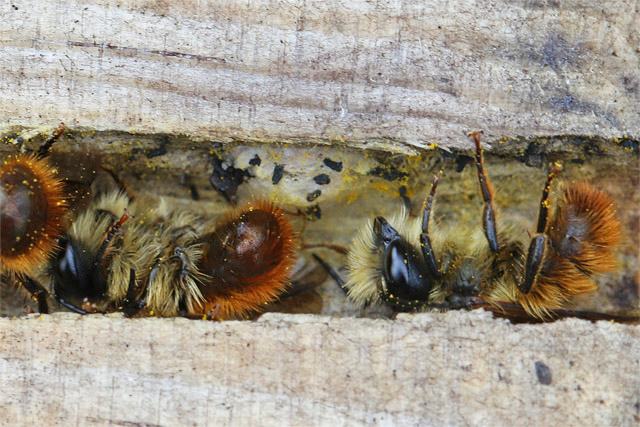
There are over 120 species of solitary bee and wasp in Ayrshire. Some are relatively easy to find, if one knows where to look. For example, south-facing, old walls are reasonably reliable habitat for the small, black Slender Digger Wasp Crossocerus elongatulus; large patches of Blaeberry on the degraded parts of raised bogs often produce sightings of the ‘upland’ solitary bees, Andrena lapponica and Lasioglossum fratellum; and searching Hogweed flower-heads in dune systems in July is a productive method for finding the stripy mining bee Northern Colletes Colletes floralis.
However, other species are much more difficult to find. In particular, many stem-nesting and hole-nesting species (as opposed to ground-nesting species) are rarely encountered. Often the best way to find such elusive species is to use trap nests. A trap nest is essentially an artificial structure designed to encourage bees and wasps to nest in it. For example, hollow garden canes or the cut stems of Common Reed are often bundled together and positioned in a sunny spot in the hope that solitary bees and wasps will nest in them. At the end of winter, the stems can be opened and the bee and wasp pupae removed. In a few months, the pupae hatch and the adult bees and wasps can then be identified to species.
Common trap nest occupants
Two of the most frequent occupants of trap nests in Ayrshire are the Red Mason Bee Osmia bicornis and the Wall Mason Wasp Ancistrocerus parietinus. The two species look very different: the former is a hairy, black and orange mason bee, the latter a large, black and yellow mason wasp. However, the presence of their nests is indicated by the same thing: a muddy plug blocking the trap nest entrance. In contrast, leaf segments blocking the nest hole indicate that leaf-cutter bees are in residence. Willughby’s Leaf-cutter Megachile willughbiella and the Patchwork Leaf-cutter Megachile centuncularis are probably the two leaf-cutter species most commonly found in trap nests. In suitable habitat near the coast, the Brown-footed Leaf-cutter Megachile versicolor can also turn up.
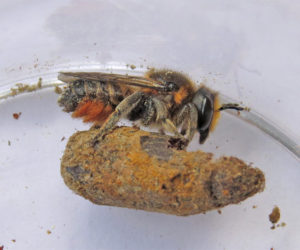
A good way to find rare species
One of the attractions of trap nesting is that it is a good way to record uncommon species. My trap nests at Ardeer have produced a few Hairy Yellow-face Bees Hylaeus hyalinatus, a rare species in Scotland. Trap nests positioned on sun-baked walls and steep, sandy embankments have attracted Dipogon variegatus. There are only a few records of this uncommon spider-hunting wasp in Scotland. Amongst the numerous Osmia bicornis nests are occasional nests of the rarer mason bee, Blue Mason-bee Osmia caerulescens. All Ayrshire records of this species pertain to individuals seen in or around trap nests.
Trap nesting is a particularly good way to find ‘cuckoos’ – species that lay their eggs in the nests of other bees and wasps. Many cuckoos are rarely encountered unless reared from nests. Ayrshire’s first record of Chrysis impressa, a species of cuckoo wasp, came from a trap nest installed in Eglinton Park by ranger, Alistair Murdoch. Some of my trap nests at Ardeer have been taken over by the rarely seen cuckoo bee the Dull-vented Sharp-tail Coelioxys elongata.
Trap nesting will undoubtedly be key to adding new species of bee and wasp to the Ayrshire list. There are no verified records of the stem-nesting wasps Trypoxylon and Passaloecus from Ayrshire. Tropoxylons in particular are infamous for being difficult to find without trap nesting. Because of the frequency with which Osmia bicornis colonises trap nests, there is a good chance that its cuckoo, Sapyga quinquepunctata, will be found in attendance at, or reared from, trap nests. There are no confirmed records from Scotland, but it has bees sighted just south of the Scottish border.
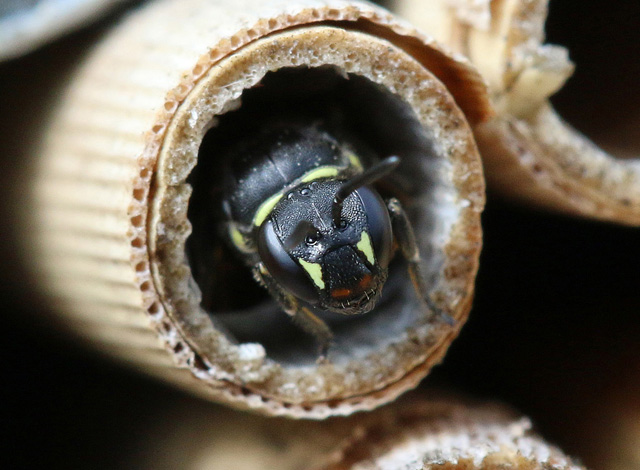
Another species of cuckoo wasp that is unlikely to be encountered unless reared from a nest is Trichrysis cyanea. This metallic blue-green wasp has been recorded in Scotland only once and is a cuckoo of stem-nesters, such as Pemphredon lethifer and Trypoxylons. Trap nesting in South Ayrshire might also result in the rediscovery of Coelioxys inermis, a cuckoo bee recorded at Culzean over 100 years ago, but not seen since. Coelioxys bees are infamous for being only rarely seen. However, they are often reported from trap nests and ‘bee hotels’.
A guide to trap nesting
The cheapest and easiest way to build a trap nest is to harvest suitable materials from the countryside in winter. The hollow stems of Common Reed are commonly used as trap nest material. They should be cut into lengths of at least 12cm long. Each cut length of reed should have a node at one end (i.e. be closed at one end) and be open at the other. Hollow bamboo canes can also be used and have the advantage that, unlike Common Reed stems, they are almost completely waterproof. The stems/canes should be bundled together and positioned in a sunny, sheltered south or south-east facing spot, ideally with some kind of protection from the rain, such as a slate, placed over it, but not protruding over the entrance holes.
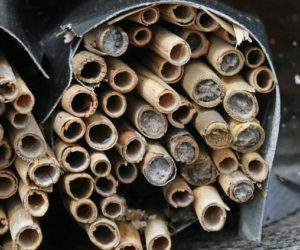
A more technically involved way of creating trap nests is to mechanically create grooves in short planks of wood and then place the planks of wood together so that the grooves become tunnels.
The trap nest should be retrieved from the countryside in late autumn and stored in a cold shed or garage over winter. Storing it indoors in this way will decrease the chance of the pupae getting damp and dying, which is particularly a problem in Ayrshire, because of its wet climate. It is essential that the trap nests are not stored in a warm environment: the insects inside need to experience a spell freezing (i.e. frosty) conditions in order to develop into adults. If no garage or shed is available, then the trap nest can be left outside until March, but should ideally be protected from the rain in some way, perhaps by placing it under cover.
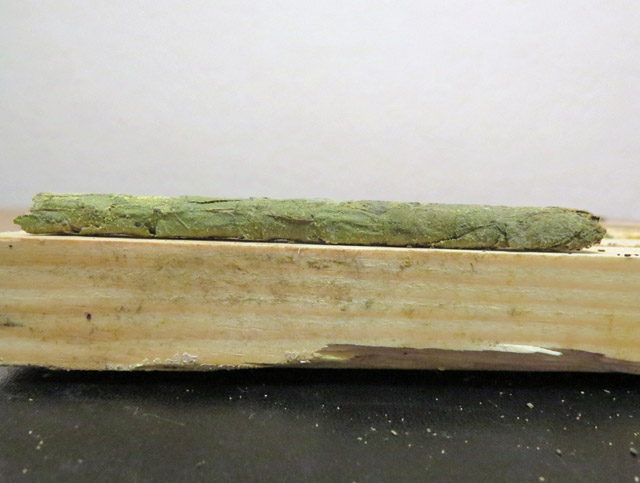
In March, the trap nests can be opened and the pupae removed. Perhaps easiest is to store each pupa in an individual pot. Each pot should be covered with mesh so as to allow air into the pot but prevent any insects from escaping. The potted pupae can then either be taken indoors into a warm environment, but they should be kept away from any source of direct heat, such has windows and radiators). The adults should emerge in about a month or two. Alternatively, they can continue to be stored in a cool, dry place. The latter approach will result in the insects emerging during their natural season of emergence and is ideal if you want to release the insects back into the wild.
When the adults emerge, they can then be identified to species.
